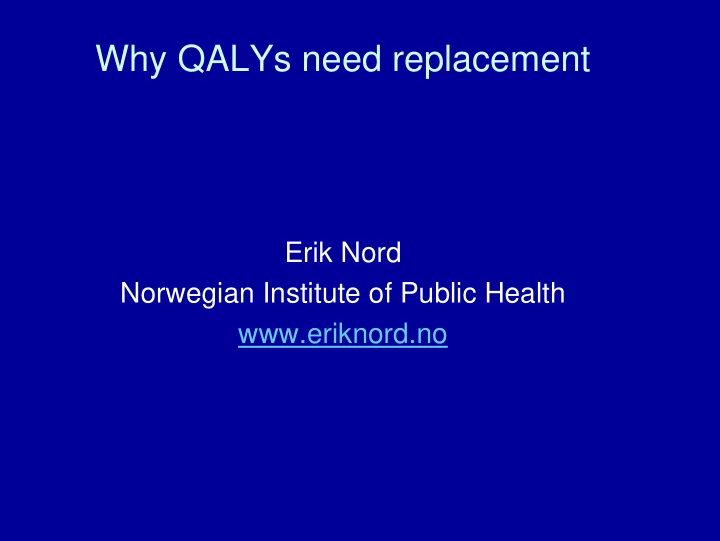

Why QALYs need replacement Erik Nord Norwegian Institute of Public Health www.eriknord.no
The purpose of QALYs Inform and aid - not dictate - decision makers .. .. by allowing calculations of value for money.
Decisions where calculations of value for money may be of interest. 1. Choosing between interventions in a given disease area. ☺ ! 2. Priority setting between diagnostic groups / disease areas. - in UK, US, Canada, Australia and many others. Germany: ?? between individuals (in admissions/treatments). of interest (but note Weinstein,1981; Williams,1987;Torrance,1987!).
The issue in Germany: Setting ceiling prices. IQWIG may find some of the QALY methodology useful even if no interest in comparisons across disease areas.
QALYs illustrated Utility 1 0.8 B: 2 QALYs 0.6 A C: 6 QALYs 0 0 1 10 Years
Multi-attribute utility instruments . Example: EQ-5D (preferred and recommended by NICE) Dimensions: (1) Mobility, (2) self care, (3) usual activities, (4) pain, (5) depression/anxiety Levels: 1: No problem; 2: some problems; 3: severe problems Examples from value table (time trade-offs in UK general population): A: 21211. ca. 0.8 B: 22221. ca. 0.6
Why QALYs need replacement in priority setting between groups.
Evidence of societal values concerning priority setting between groups • Ethics literature, e.g. John Harris, Norman Daniels • Government commissions, e.g. Norway 1987, Holland 1992, New Zealand 1993 • Studies of population preferences 1991-2000, including Nord E, Richardson J, Pinto JL, Dolan P and Cookson R, Tsuchyia A, Bryan S, Ubel P et al, Abel Olsen J, Schwappach D, Schwarzinger M
Norwegian Government Commission 1987: 1. Severity is of primary importance. 2. Everybody should have the same possibility to become as well as they can ( = realize their health potential).
Examples of studies of population values and preferences. For reviews see e.g. : Nord E. Cost-value analysis in Health Care. Cambridge University Press 1999. Dolan P, Shaw R, Tsuchiya A, Williams A. QALY maximisation and people's preferences: a methodological review of the literature. Health Economics 2005,14, 197-208.
Priority setting between groups: Problems with ’utility subtraction’ illustrated with EQ-5D 21211 (A) and 22221 (B) I S S U E S Disutility in % Utility Severity & Potential Life saving (general pop.) P1 P2 P3 P4 P5 H 0 1.0 A 20 0.8 B 40 0.6 D 100 0.0
Severity (1) P1 P2 Nord, 1991, EQ-5D rating scale values vs person trade-offs: V(A)=0.2; V(B)=0.6. PTO: 1 A = 50 B. Similar: Ubel et al, 1996; Pinto 1994, 1997.
Severity (2) P2 P3 Richardson J, 1997, rating scale vs PTO: P2: 75=>90; P3: 5=>20. PTO: 1 P3 = 2 P2. Similar: Nord 1993; Dolan 1998
Potential P1 P3 Nord, 1993: How should a given budget be divided? Most to P1: 24 %; Split even: 72 %. Similar: Pinto and Perpinan, 1998; Dolan and Cookson, 1998.
Life saving P4 P5 Intuition and ethics literatur (e.g. Harris, 1987): Equal priority Nord, 1993, restoration to full health vs to crutches & moderate pain, PTO: Equal priority Similar: Ubel, Richardson and Pinto, 1999.
The value of duration 10 20 Abel Olsen, Norway, 1994: 100 persons, 10 years gained = 80 persons, 20 years gained Dolan and Cookson, York Regional Health Authority, 1998: Little differentiation between 10 and 20 years gained.
Conclusion so far QALY calculations may give quite poor guidance for priority setting between groups, due to: 1. Lacking concern for severity. 2. Too strong emphasis on capacity to benefit. So what to do?
(1) Valuing gained life years in less than full health • Refrain from quality adjusting gained ’liveable’ life years. (Nord et al 1999, cfr also DALYs.)
(2) Valuing different quantities of gained life years Increased discount rate? years above a certain number, eg 10 years?
(3) Valuing gains in functioning/QoL: Transformation of utilities. (Nord, 1996, cfr. Nord, Richardson, Pinto et al, 1999.) Values for valuing change 1.0 B’ 0.95 A’ 0.8 Utilities from the viewpoint of healthy A:0.4 B:0.7 1.0
Example of transformation: EQ-5D EQ-5D Societal value for priority setting A (22221) 0.60 0.96 B (21211) 0.80 0.99 A=>B 0.20 0.03 B=>Healthy 0.20 0.01 A=>Healthy 0.40 0.04 (Transformations for various MAU instruments suggested in Nord E, Annals of Medicine 2001, 33, 371-374).
Replacing QALYs in the method described by IQWIG’s international panel
Why QALYs at all? From effect to value. E.g.: From having some problems with walking, self care, work activities and having some pain To some problems with walking, some dizziness. MAU instruments can be helpful.
Two ways of ’replacing QALYs’ 1. Forget QALYs if simpler measure of value is available. 2. Transform utilities and QALYs if simpler measure of value is not available.
Transforming utility gains: Example using EQ-5D Value T1: 0.60 => 0.80: 0.03 0.40 T2 T4 T2: 0.60 => 1.00: 0.04 T3: 0.80 => 1.00: 0.01 T4: 0.40 => 0.80: 0.20 0.20 T3 T1 T4 T2 T1 T3 0 Costs per patient per year Note: No efficiency frontier drawn.
Similar modification of QALYs possible for duration
Conclusion Cost-utility analysis (CUA) in terms of QALYs can be replaced by more valid and fair cost-value analysis (CVA). CVA can draw upon extensive utility data elicited in the QALY field. Thus no reason to refrain from comparisons across therapeutic areas. If, nevertheless, only within-area analyses are of interest, QALYs may be replaced a. by simpler measures when appropriate, b. or by transformed values (CVA) when necessary. Whichever measure of value is used, the information value of the International Panel’s diagrammatic approach lies in the whole plot.
Recommend
More recommend